
Bulletin 9-10 (V:1-2), 1967
Home
Français
Introduction
History
Annual Index
Author &
Subject
Credits
Contact
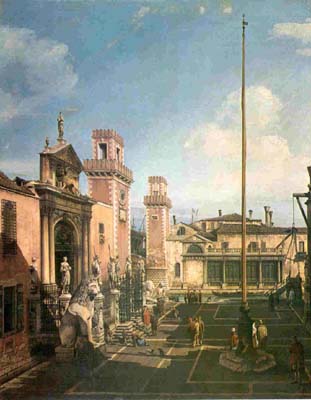


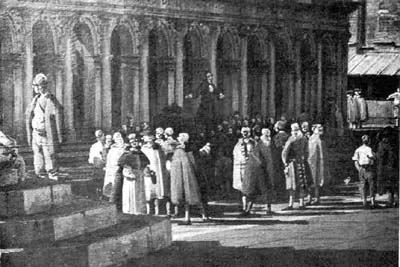
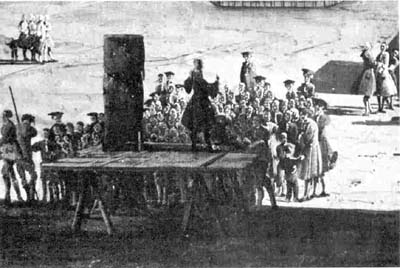
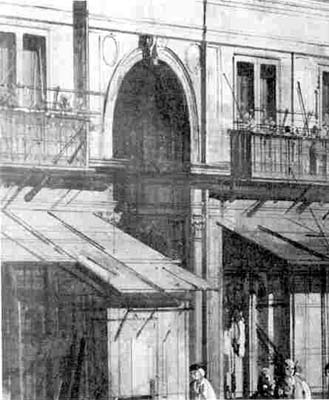
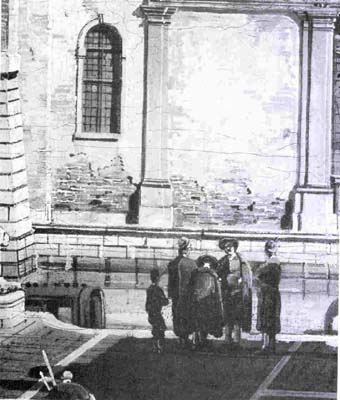
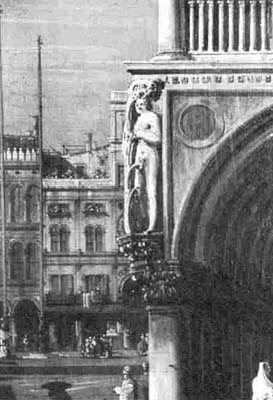
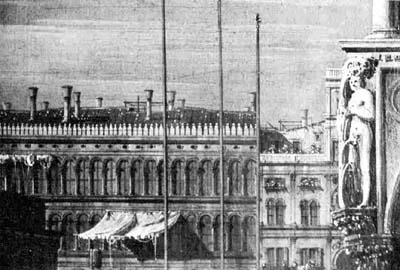


Bernardo
Bellotto's Venetian Period (1738-1743)
by Professor Terisio
Pignatti, Vice-Directore
Musei Civici Veneziani
Pages 1 | 2 |
3 | 4
Such a distinction appeared artificial, and it confirmed the doubts
that I had at the beginning. If the four paintings really did belong
to a single series, I was convinced that the apparent difference in
style, that had led to their being placed in an unsubstantiated
chronology over a period of ten years, was due to the fact that the
person who painted them was still a novice. The "Canalettism"
of the four paintings could be explained more logically by placing
them near prototypes that might have been models for the young
Bellotto while he was being taught by his uncle. (15)
Once I was convinced that the four paintings were not by Canaletto
and that an attempt should be made to remove them from the list of
his works, I thought it desirable to see whether they could be by
Bellotto, for they would be important additions to what little we
know of his Venetian Period. If the four canvases were painted by
Bellotto, the distinctive characteristics of his work that have
already been described should apply to them. (16)
First of all, space in these four canvases is rendered in the same
way as it is by Bellotto. If they are compared to paintings of the
same subject by Canaletto such as the
Piazzetta Looking South
or
the
Entrance to the Grand Canal
from the Windsor Collection, it can be
seen that a more decisive angle has been chosen, the foreground
widened and the background described with greater precision. It is a
theatrical conception of space but one always controlled by a
preoccupation with drawing everyday life in the most exacting detail
and in the clearest light.
The lighting is also rendered in a way that is characteristic of
Bellotto's work. In the
Piazza della Signoria
(plate 17) from the
museum in Budapest, dated 1742, and in the
Porte del Dolo
(plate 4),
dated 1748, there is a sharply-outlined shadow coming from the right
and spreading like a carpet over the square there is a similar
shadow in
The Arsenal
(plate 16). Figures move in the shaded
foreground, like cut-out silhouettes; such Chinese shadows are often
found in other paintings of the period from 1742 to 1745, for
example in the
Piazza Navona
in the Brown Boveri Collection, and in
the
View of the Arno
in the collections of the Fitzwilliam Museum
and of the museum in Budapest.
Bellotto's characteristic sketches of human figures can also be seen
in these paintings. From the beginning, unlike Canaletto, he showed
an inclination toward characterization, to topical themes, in short,
to realism, in drawing people. Nobody could confuse the accurate
caricatures in Bellotto's
View of the Kreuzkirche of Dresden
(plate
18) with the curled chinoiseries of Canaletto's figures in the
contemporary Procuratie Nuove, San Marco
(plate 19) in the National
Gallery, London. At the end of his career, in Warsaw, Bellotto used
to insert large figures and even portraits into his paintings. In
the four works under consideration highly characterized figures, too
strongly emphasized to be by Canaletto, form groups which play a
dominant role in the total effect. In the Entrance to the Grand
Canal, there is a group with a nobleman talking to a veiled woman,
and another of commoners on the steps of the column of Todar; in the
Piazzetta Looking North,
there is a group of idlers near the arcades
of the Ducal Palace; in The Arsenal,
there is a group standing in
the sun in front of the Arsenal's gate. The figures always assume a
genre pose; the faces are characterized and highlighted in a special
way which makes them unnaturally bright, almost like masks - a mask
with grotesque, heavy black eyes and a ball-shaped nose placed in
the middle of the face like a cork.
Bellotto's figures were made with brush strokes of bright
contrasting colours. On the other hand Canaletto's figures in
The
Vegetable Market
and
San Giacometto di Rialto
(plate 6) and in the
Piazza San Marco
(plate 7) from the National Gallery of Canada show
numerous gradations of colour from the wigs to the cloaks, trousers
and shoes. Canaletto's fine paint brush moved continuously along the
sinuous curves with zinc white, creating a special sort of
transparent highlight - the characteristic "ricciolo.' or swirl
of Canaletto; this does not appear in the four paintings in
question. In these paintings, the figures are quite corpulent and
plastic; they are composed of a few pure colours that were rarely
mixed to create tonal nuances. The movement of the brush is also
different, much more rectilinear, giving the figures a squared
appearance. The difference between these figures and Canaletto's can
be seen when the figure of the Gentleman in the
View of the Zecca
(plate 20) is compared with the copy of the same figure in the
Piazzetta Looking North
(plate 21). There has been a transition from
the most refined pictorial poetry to a very objective, simplified
prose.
Another interesting comparison could be made between the people
clustered around the charlatan in the
Piazzetta Looking North
(plate
22) and the one in the
Piazza della Signoria
(plate 23) from the
museum in Budapest, which is definitely attributed to Bellotto;
these two groups are identical.
The architecture in the four paintings is also rendered in a way
that is characteristic of Bellotto. Although both Bellotto and
Canaletto underlined the shadows and the cornices of their
buildings, Canaletto covered the lines with thin successive strokes
of colour which gave an atmospheric effect (plate 24), while
Bellotto applied thick parallel strokes juxtaposed like small mosaic
tiles with strokes of light for the mortar between the bricks and
the stones (plate 25). This technique of Bellotto's can be seen in
the Dresden paintings such as the
Porte del Dolo
(plate 10) and the
View of the Kreuzkirche
as well as in
The Arsenal
(plate 26).
Bellotto also gave light to the surface of walls with strokes of
burnt umber heightened with white lead and cadmium yellow; for
example the Roman arches in the canvas from
Parma of 1742
(plate
27). (18) He depicted columns in a very special way: the veins of the
marble were rendered by a series of horizontal brush strokes cut
vertically by streaks of shimmering light. The columns in the four
paintings in question are surprisingly similar to those that are
characteristic of Bellotto. He would use streaks of cadmium yellow
to highlight the edges of cornices, for example in the
Capriccio
Romano
(plate 28) and in the door of the
Kreuzkirche
(plate 18);
these streaks have not been found in any of Canaletto's work. The
yellow streaks do appear, however, in the arches of the Ducal Palace
in the Piazzetta Looking North (plate 29), and along the arches of
the Library in the
Entrance to the Grand Canal
( plate 14).
Bellotto's technique of painting terracotta-tiled roofs is also very
characteristic and helps distinguish his work from Canaletto's. The
roof of the small house in the centre of the
View of the Po
(plate
30), a painting definitely attributed to Bellotto, is exactly the
same as that of the
Procuratie Vecchie in the Piazzetta Looking
North
(figure 31). This characteristic rendering of architecture in
Bellotto's youthful work is found in the
View of the Adige at Verona
in Dresden
(plate 32) as well as in the
Piazzetta Looking North
(plate 33).
The date of these four canvases must now be determined. The Venetian
subject matter does not in itself indicate that the paintings were
made between 1738 and 1743 because Bellotto painted Venetian scenes
such as the views of
Verona, Porte del Dolo and Bacino e San Giorgio
while he was in Dresden in 1747 and 1748. (19) The freshness and
imagination of these canvases suggest, however, the moment of first
creative enthusiasm - the moment of the artist's discovery of his
own ability - rather than a style tested and subtle like Bellotto's
in Dresden. The similarity between these paintings and those from
his Roman or Florentine period would indicate a date between the
Darmstadt drawing of 1740 and 1742.
For all these reasons I think that the four paintings should be
moved from their place in Canaletto's work to Bellotto's Venetian
period. (20) Although these works are sufficiently close to
Canaletto's to have justified their being attributed to him, they
still show the first distinctive style of an artist who was destined
to play an important role in the history of eighteenth-century
European painting.
Next Page | Notes
1 |
2 | 3 | 4
Annual Index | Author & Subject | Credits | Contact
This digital collection
was produced under contract to Canada's Digital Collections program,
Industry Canada.
"Digital
Collections Program, Copyright
© National Gallery of
Canada 2001"